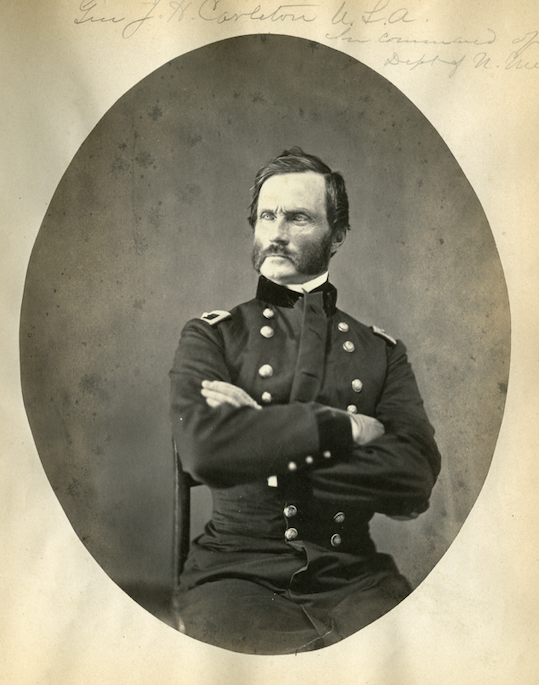James Henry Carleton produced more primary document material than the other eight protagonists in The Three-Cornered War combined.
As commander of the 1st California from 1861-2, and then the Department of New Mexico from 1862-67, Carleton wrote copious letters and reports to his superiors and his subordinates. His words were reprinted and reported in New Mexico’s newspapers, and his testimonies were central to the investigations of Bosque Redondo, the disastrous prison camp/reservation that he established for Navajos and Mescalero Apaches in 1863-64.

Carleton was a micromanager. He also just loved to write. Growing up in Maine, he had wanted to be a novelist. When he was twenty-four, he wrote a letter to Charles Dickens, enclosing a sample of his writing and asking if he should move to London in order to join that city’s literary set. In a kindly worded letter back to the aspiring writer, Dickens suggested that his talents lay elsewhere. So Carleton joined the military.
Over his twenty-year career as a dragoon before the Civil War, Carleton served in frontier forts across the West (including Albuquerque and Santa Fe), leading cavalry companies on Indian campaigns. In 1861, he was at Fort Tejon outside of Los Angeles with his wife Sophia and their three children. That fall, he was tapped to command the 1st California, and lead them on the march from Los Angeles to the Rio Grande, to help E.R.S. Canby fend off Henry Sibley’s Texan army. From that point on to his removal from command of the Department of New Mexico six years later, he never took a furlough. It is unclear if he ever saw his family again.
Readers will follow Carleton and his California soldiers on this arduous march through the desert, and into their fights with Mangas Coloradas’s Chiricahua Apaches along the way. They will come to know him as the architect of the Union Army’s campaigns against the Chiricahuas, Mescaleros, and Navajos, and discover why Carleton’s decision-making regarding Bosque Redondo resulted in tragedy and heartbreak for the Navajo women, men, and children imprisoned there.
During the Civil War, James Carleton enacted the Lincoln Administration’s and the Union Army’s directives in the West, launching campaigns against Native peoples in order to remove them from the lands that the federal government coveted. He was a hard man, and a personification of the U.S. government’s remorseless Indian policy in the Civil War West.
***
To tell James Carleton’s story, I used military records collected in the OR and in Records of California Men in the War of the Rebellion; testimonies regarding Bosque Redondo in Condition of the Indian Tribes: Report of the Special Committee Appointed under Joint Resolution of March 3, 1865, with Appendix; New Mexico newspaper accounts of Carleton’s actions and conditions at Bosque Redondo; Navajo oral histories; Aurora Hunt’s biography of Carleton (Major James Carleton, 1958) and her study of the 1st California (The Army of the Pacific, 1951); and Andrew Masich’s The Civil War in Arizona (2006).
Ms. Nelson,
I purchased your book Three Cornered War while on vacation this summer. (Sun Dog Books, Seaside, FL).
The history is, of course, fascinating, but above that the structure and quality of your prose is just first rate.
It’s so just so readable. Thanks for all your hard work. MLM